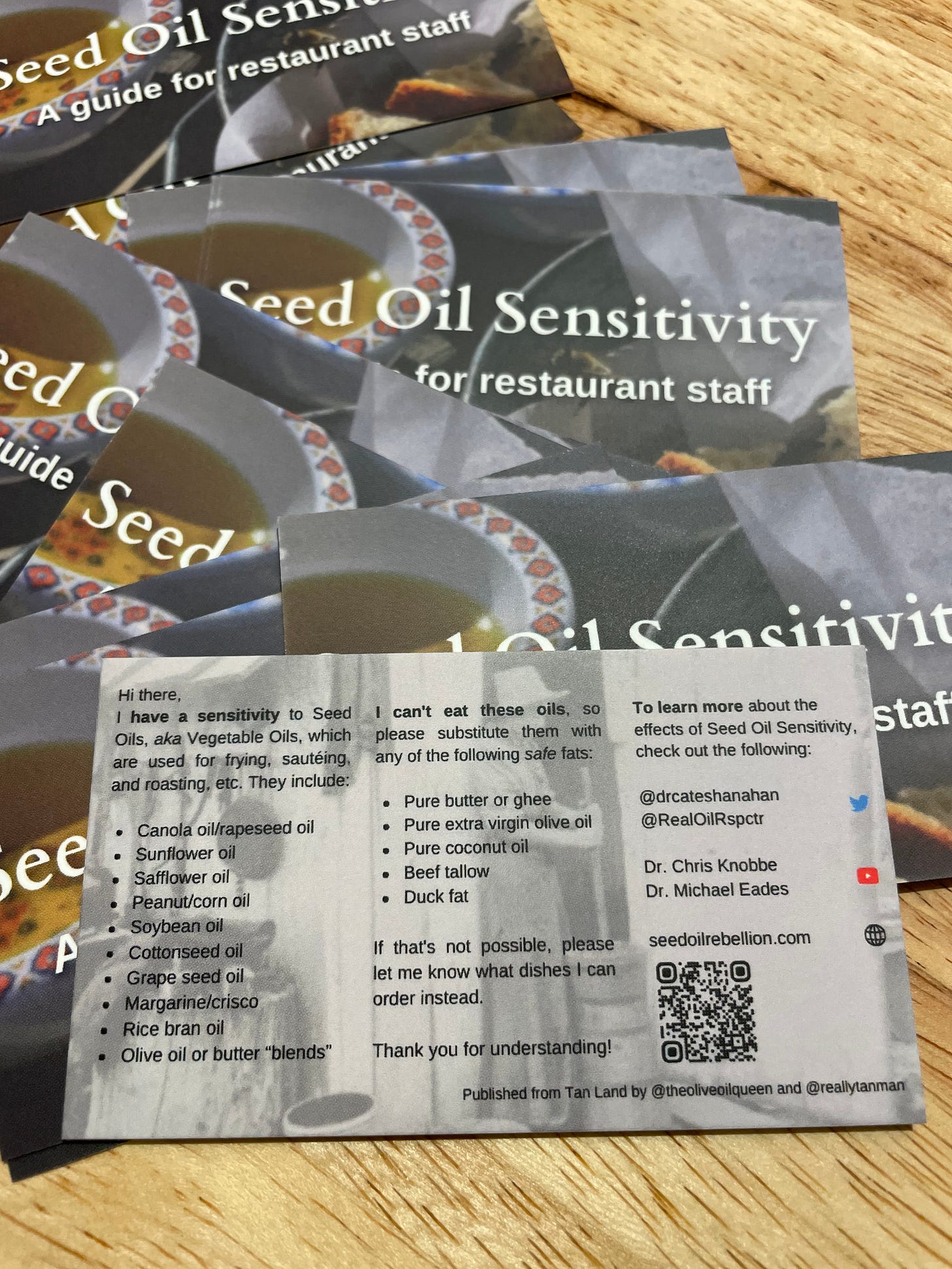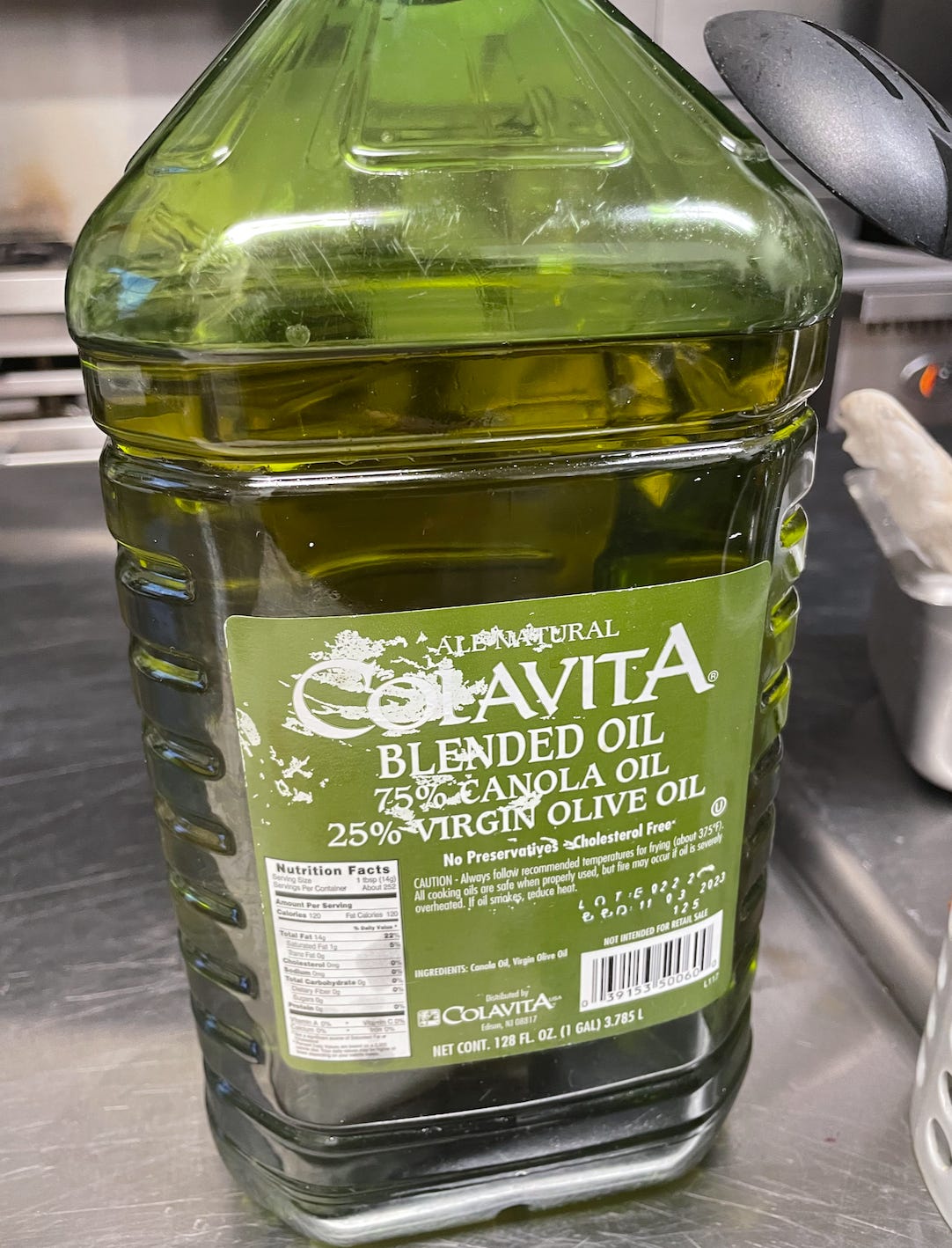Eating out can be difficult if you are a victim of Seed Oil Sensitivity, a silent but deadly condition which afflicts 90%+ of Americans worldwide.
Symptoms include obesity, acne, cellulite, sunburn, cancer, diabetes, and death.
Most restaurants neglect this underserved population by lacing most of their food with seed oils and failing to disclose it to unsuspecting customers.
But have hope— if you have Seed Oil Sensitivity you can still eat out safely if you know how to Talk to Your Waiter about Seed Oil Sensitivity™.
If you follow the steps in this guide, we can all stop the victimization of Seed Oil Sensitive Americans. Here’s how:
1. Know what to avoid
You can’t avoid seed oils if you don’t know what they are. There are a lot of them, and as someone with Seed Oil Sensitivity you should probably memorize them— it’s a matter of life and death after all.
But for now, you can check your Seed Oil Sensitivity Card (more on this later) for a complete list:

They are commonly used in sauces, dips, aoilis, marinades, and of course in deep frying.
2. Know what’s safe
Also make sure you are familiar with the type of fats that are safe for someone with Seed Oil Sensitivity to eat instead.
Butter or extra virgin olive oil are the easiest to find, so start with those.
But remember, they must be pure!
3. Avoid deep fried foods
Unless you are at a traditional fry shop in Belgium, or an American restaurant that specifically advertises tallow/duck fat fries, every single deep fryer is loaded with seed oils.
Deep frying is the worst way to prepare seed oils, since the constant heat degrades them to an incredibly carcinogenic state. (Keep in mind that it’s due to the seed oils themselves, not the frying per se).
It’s pretty easy to tell what’s deep fried, but if you’re unsure just ask. Common deep fried foods:
French fries
Chicken wings/tenders
Anything coated in a breading of some kind
Onion rings
Calamari
Anything that says “fried”
4. Choose simple meals
Every additional side, ingredient, or preparation step increases the chances that seed oils sneak into your food.
That’s why it’s best to order simple dishes. It’s also easier to request a substitution when fewer ingredients must be changed.
Good dishes to order for the Seed Oil Sensitive include a meat, a starch, and maybe some veggies. Keep in mind that more complicated things, like soups, are often made in advance and can’t be substituted.
5. Know the safe options
In the same vein, certain types of dishes are naturally safer.
These include:
Sushi or sashimi
Meat or fish grilled directly on an open flame
Steamed rice and veggies (because many customers want “no fat” options)
Baked potatoes
Boiled or poached eggs
If I were at a stakehouse for example, I’d order a steak (making sure it’s cooked on an open flame) and a baked potato with butter (making sure it’s not margarine). That’s it.
6. Eat at better restaurants
Not only will nicer restaurants make each dish to order, so it’s easier to substitute ingredients; they are also accustomed to accomodating food sensitivities.
They typically source better ingredients, often from local farms, so it’s better to support them anyhow.
Are they more expensive? Yes.
But you get what you pay for. Instead of eating out often at crappier restaurants, and getting seed oil filled food which makes you miserable, you could have more enjoyable experiences at better restaurants for the same money, albeit less frequently.
7. Share your SOS Card with the server
Once you know what to avoid and have chosen a better restaurant, it’s time to talk to your server about Seed Oil Sensitivity.
It’s a very serious condition, so treat it as such. But keep in mind that it’s not widely known yet, so try to be understanding.
Start by asking if the dishes you want contain seed oils. If the server is unsure what that means (as most are), your Seed Oil Sensitivity Card is a quick reference guide and instruction manual for your server and the chef.
Keep a stack of them with you (you can print them same as you would a business card), and politely present one to the server. You can ask her to give it to the chef to double check, since it is unlikely the server knows all the dishes including seed oils.
Using this card is a lot easier than trying to explain it to the servers:
“I can’t eat seed oils”
“What are seed oils?”
“Oils like canola and soybean oil”
“Okay I’ll check with the chef” [checks with chef…] “Is safflower oil okay?”
Such confusion. Seed Oil Sensitivity is a serious condition, and deserves to be treated as such. This card will help with such perception, and encourage them to work with you to make sure there is no unfortunate contamination.
It might take a few back and forths with the kitchen to figure out what they can cook that will suit you. Be gracious and flexible, but firm. You have Seed Oil Sensitivity— there’s nothing you can do about that. It’s their job to accomodate.

If they do a good job, make sure to tip well. Let them know that those afflicted with Seed Oil Sensitivity are pleasant and generous customers; this will make them more accomodating in the future.
8. Further education
As victims of Seed Oil Sensitivity, it’s easy for us to complain about how restaurants marginalize us with seed oil laced food, but such grumbling is useless if we don’t do anything about it.
Every chef or server informed about Seed Oil Sensitivity brings us one step closer to a seed oil free world.
Encourage them to learn more about it, as more and more of their customers are becoming afflicted by this terrible condition. There is helpful information to be found by scanning the QR code on the back of the SOS card in book, video, and blog format.

As restaurants become more aware, they will be able to become more inclusive of all guests. This means more money for them, and a seed oil free life for you.
Everyone wins.







Does hot water bath work like a sauna? Which type of sauna do you recommend? What is the mechanism?--heat? Red light? Sweat?
Does hot water bath work like a sauna? Which type of sauna do you recommend? What is the mechanism?--heat? Red light? Sweat?